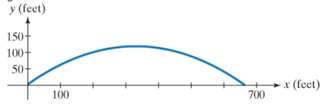
The path of a projectile that is launched h feet above the ground with an initial velocity of t\) feet per second and at an angle 0 with the horizontal is given by the parametric equations
where t is the time, in seconds, after the projectile was launched. The parametric equation for x gives the projectile’s horizontal distance, in feet. The parametric equation for y gives the projectile’s| height, in feet. Use these parametric equations to solve Exercises 69 -70.
The figure shows the path for a baseball that was hit with an initial velocity of 150 feet per second at an angle of 35° to the horizontal. The ball was hit at a height of 3 feet off the ground.

a. Find the parametric equations that describe the position of the ball as a function of time.
b. Describe the ball's position after 1, 2, and 3 seconds. Round to the nearest tenth of a foot. Locate your solutions on the plane curve.
c. How long is the ball in flight? (Round to the nearest tenth of a second. ) What is the total horizontal distance that it travels, to the nearest tenth of a foot, before it lands? Is your answer consistent with the figure shown?
d. Use the graph to describe something about the path of the baseball that might be of interest to the player who hit the ball. Then verify your observation algebraically.
Want to see the full answer?
Check out a sample textbook solution
Chapter 10 Solutions
Algebra & Trigonometry With Additional Material From College Algebra Essentials (custom Edition For Tidewater Community College)
- e). n! (n - 1)!arrow_forwardSuppose you flip a fair two-sided coin four times and record the result. a). List the sample space of this experiment. That is, list all possible outcomes that could occur when flipping a fair two-sided coin four total times. Assume the two sides of the coin are Heads (H) and Tails (T).arrow_forwarde). n! (n - 1)!arrow_forward
- Evaluate the following expression and show your work to support your calculations. a). 6! b). 4! 3!0! 7! c). 5!2! d). 5!2! e). n! (n - 1)!arrow_forwardAmy and Samiha have a hat that contains two playing cards, one ace and one king. They are playing a game where they randomly pick a card out of the hat four times, with replacement. Amy thinks that the probability of getting exactly two aces in four picks is equal to the probability of not getting exactly two aces in four picks. Samiha disagrees. She thinks that the probability of not getting exactly two aces is greater. The sample space of possible outcomes is listed below. A represents an ace, and K represents a king. Who is correct?arrow_forwardConsider the exponential function f(x) = 12x. Complete the sentences about the key features of the graph. The domain is all real numbers. The range is y> 0. The equation of the asymptote is y = 0 The y-intercept is 1arrow_forward
- The graph shows Alex's distance from home after biking for x hours. What is the average rate of change from -1 to 1 for the function? 4-2 о A. -2 О B. 2 О C. 1 O D. -1 ty 6 4 2 2 0 X 2 4arrow_forwardWrite 7. √49 using rational exponents. ○ A. 57 47 B. 7 O C. 47 ○ D. 74arrow_forwardCan you check If my short explantions make sense because I want to make sure that I describe this part accuratelyarrow_forward
 Algebra and Trigonometry (MindTap Course List)AlgebraISBN:9781305071742Author:James Stewart, Lothar Redlin, Saleem WatsonPublisher:Cengage Learning
Algebra and Trigonometry (MindTap Course List)AlgebraISBN:9781305071742Author:James Stewart, Lothar Redlin, Saleem WatsonPublisher:Cengage Learning Trigonometry (MindTap Course List)TrigonometryISBN:9781305652224Author:Charles P. McKeague, Mark D. TurnerPublisher:Cengage Learning
Trigonometry (MindTap Course List)TrigonometryISBN:9781305652224Author:Charles P. McKeague, Mark D. TurnerPublisher:Cengage Learning Trigonometry (MindTap Course List)TrigonometryISBN:9781337278461Author:Ron LarsonPublisher:Cengage Learning
Trigonometry (MindTap Course List)TrigonometryISBN:9781337278461Author:Ron LarsonPublisher:Cengage Learning- Algebra & Trigonometry with Analytic GeometryAlgebraISBN:9781133382119Author:SwokowskiPublisher:Cengage



